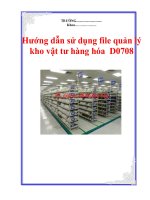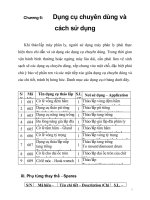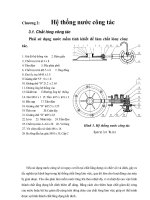huong dan su dung tien xu ly anh ve tinh bang ILWIS
Bạn đang xem bản rút gọn của tài liệu. Xem và tải ngay bản đầy đủ của tài liệu tại đây (1.25 MB, 17 trang )
Pre-processing imagery
Joan Looijen
TOPICS
•
•
•
•
•
•
•
•
Why land cover mapping?
Land cover classification
Data requirements
Pre-processing imagery
(FC & NDVI)
Image classification
Data collection
Land cover mapping
Accuracy assessment
J. Looijen
PRE-PROCESSING IMAGES
• This phase includes the standard operations of
geometric correction, image referencing, image
enhancement and, if needed, the application of filters
• All data are georeferenced to UTM WGS 84,
Zone 48 N
J. Looijen
COLOUR COMPOSITES
• Besides geo-referencing and radiometric
corrections we need to make sure that the objects
of interest can be distinguished
• The spectral information stored in the separate
bands can be integrated by combining them into a
colour composite
• Many combinations of bands are possible
• The spectral information is combined by displaying
each individual band in one of the three primary
colours: red, green and blue.
J. Looijen
ELECTRO-MAGNETIC SPECTRUM
J. Looijen
REFLECTION CURVES VEGETATION
• If in land cover classification and mapping you will
mainly concentrate on the mapping of vegetation
cover, including agricultural fields, you have to select
those band combinations that give you the ideal
reflectance
• This differs per satellite image.
J. Looijen
FALSE COLOUR COMPOSITES
• Human eye cannot see the high reflection in the near
infrared and middle infrared radiation
• Since the human eye is very sensitive for different
shades of red, the infrared band is displayed in red.
• False Color Composite (FCC):
the red color is assigned to the near-infrared band,
the green color to the red visible band and
the blue color to the green visible band.
J. Looijen
REFLECTANCE CURVES - SENSORS
J. Looijen
FC LANDSAT
• Which band combinations (RGB) would you
select to create a FC based on Landsat TM 5?
• Which band combinations (RGB) would you
select to create a FC based on Landsat 8 OLI?
J. Looijen
VNREDSAT 1
• Which band combinations (RGB) would you select
to create a FC based on VNREDSat 1 imagery?
J. Looijen
VNREDSat 1
Similar to?
J. Looijen
EXERCISE FC
• Creation and use of a false colour composite & DEM
J. Looijen
NDVI
J. Looijen
RATIO IMAGES
• Ratio images are often useful for discriminating
differences in spectral variations
• Which spectral ratio to use depends upon the
particular reflectance characteristics of the features
involved and the purpose of the land cover map
• For example a near-infrared / red ratio image might
be useful for differentiating between areas of
stressed and non-stressed
Drought
Pollution
J. Looijen
NDVI
• If you would like to know the presence and
condition of the green vegetation, preparation of a
Normalized Difference Vegetation Index (NDVI)
maybe useful
• The NDVI is calculated as:
NDVI = (NIR — VIS)/(NIR + VIS)
• NDVI values range from -1 to 1
J. Looijen
NDVI
How would you estimate the NDVI values for:
No vegetation (bare soil, rocks):
Dense green vegetation:
Water , clouds, snow:
J. Looijen
EXERCISE
• Creation of a NDVI
J. Looijen









